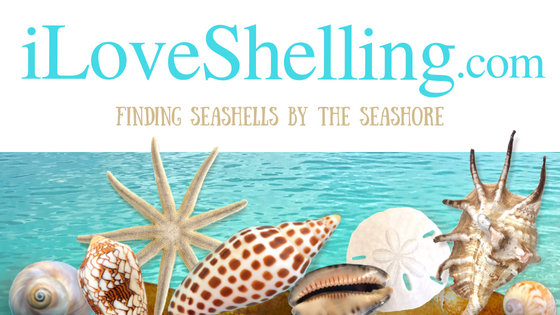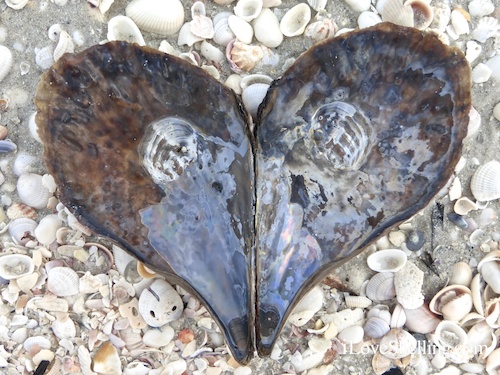While talking to Gary on our iLoveShelling shelling cruise last week, he told me about four huge HORSE CONCHS and other great shells he and his family Cameron, Mary and Lauren found on Sanibel during their visit from Nashville. Amazing!
He also asked me if PEN SHELLS could make PEARLS and I immediately answered “It’s rare to find the PEARLS washed up on the beach but… Yes they can!”. He found something that looked like a PEARL inside a PEN SHELL while looking for other shells like TRUE TULIPS which can hide or get trapped inside them (CLICK HERE for a video to show this). Of course I had to see it.
If you look closely, you can see a milky circle on the inside of his shell and at about “9 o’clock” on that circle (the MOLLUSK’s muscle scar where it was connected to the shell) you can see a little ball on the shell. That’s a PEARL.
This type of PEARL is called a BLISTER PEARL. Cool! BLISTER PEARLS are attached to the shell so mostly likely the PEARL would break if he tried pop it out to make any jewelry from it but it’s still cool for him to have seen it…. questioned it…. and ask me about it so we can all learn more.
The only reason I knew anything about PEN SHELL PEARLS was by seeing my friend Rachel Fields’ scientific display at the Sanibel Shell Festival this year…about Natural Pearls and being fascinated by her blue ribbon exhibit.
After sending her photos of Gary’s PEN SHELL, Rachel responded by saying…
“That does look like a pearl! It’s called a blister pearl when formation occurs and the growth is still attached to the shell”.
Then she explained “When pearls form often times it happens because some exterior object kind of puts pressure on and crushes the shell inward causing a piece of the shell to fall off into the body of the mollusk and if it happens near the mantle the mollusk will secrete a protective coating around that piece of shell that’s broken off. Sometimes it happens far away from the shell and more internal which causes free-formed pearls and sometimes it happens up against the side of the shell which causes the pearl to form merged to the shell (and is called a blister pearl)”.
Now you can see from Gary’s shell that his PEARL formed against the shell and it still attached…. a BLISTER PEARL. Yep, it’s just like our type of skin blisters although we make just fluid inside our blister instead of a PEARL, right? When I get a blister, I’d much rather go through the pain to get a PEARL instead of crummy fluid. LOL
When a PEN SHELL produces a FREE-FORM PEARL, it can be a gorgeous lustrous PEARL like Rachel showed in her exhibit. The problem with finding pretty PEN PEARLS is that they crack easily after a week or two and if they do make it without cracking, it may take about 4 or 5 years for them to become pearlescent.
But when they don’t crack and become lustrous…. Gorgeous!
Rachel was kind enough to share more information from her Natural Pearl presentation, so I thought it would be easier to publish a page dedicated to her research- CLICK HERE. This will probably answer all of your questions because it answered mine! Like… “What other shells make PEARLS?”.
She shows us QUAHOGS…

QUEEN CONCHS produce PEARLS as well- They are pink! I looked at the book Pink Pearl: A Natural Treasure of the Caribbean before we went on a shelling trip to Turks and Caicos last year so I could study up and keep my eye out for them. Of course its like looking for a needle in a haystack but you bet your bottom sand dollar… I searched.
This one should really get your goat… a LION’S PAW. Oh my! Just to find a LION’S PAW is special… but to find a LION’S PAW PEARL? That would send me two clouds above nine!
Thank you Gary, Mary, Cameron and Lauren for coming on the iLoveShelling cruise with me and asking me about your PEN SHELL PEARL and also to Rachel (NYC) for sharing so much invaluable information with all of us about Natural Pearls. This is another example about why i Love Shelling, Shellers and the Shelling Community! It’s so edshellcational!
CLICK HERE to see and learn more from Rachel’s Natural Pearls exhibit and more photos.















Wow, what an awesome post! Thank you for all of the great info!
Wow! Fascinating information, yes…very “edshellcational”! I would LOVE to find a pink pearl!
Pam, I had no idea that all of these other shells produce pearls. That’s amazing! Thank you you for a fun and informative post. I learn something new from you every day! Now I have something exciting to look for on my next trip to Sanibel!
Awesome post Pam. My fave thing about pen shells is that whenever i’ve found a ton of them piled up on the beach, the shelling is outrageously good!
Wow! Love all the info. Keep up the good work Pam. Pat
How interesting. Thank you for sharing this information with us. Always amazed by the things I learn from your posts.
i would have never guessed that a pearl could be in a pen shell and i’ve never kept one because i wasn’t sure if they were even shells thanx for the info sincerely R.G.
Thanks Pam! Will try to have my husband read this as he has always hated the Pen Shells and never wants me to bring any home. Now…with our 30th anniversary coming up in August…maybe he will change??? :) ( For the 30th anniversary the gift is… PEARLS … )
So very cool! No wonder Mary has always said the beach is her “happy place”. This is a great article and much of the information you’ve shared here is totally new to me. I wonder how many people think only oysters produce pearls?
As always, your shell education is the best! Of course, I also want to know where those horse conchs were found. What beach????
This has to be one of your most interesting posts ever!! I only thought pearls came from oysters. I always thought the inside of the pen shells were beautiful in color but now I’ll look at them more closely. Like Diane, I’d love to know where on Sanibel they found all those huge shells! What great souvenirs for that family!
By the way Pam, is that a half naked pen shell? I see that the book is almost $400! -used. Sorry I haven’t seen a copy. Pat
I bought a pair of beautiful blister pearl earrings at a Arts and Craft Fair in PA about 15 years ago from a couple from FL who retired to live on their sailboat and lost everything in a hurricane. They’re oval in shape because the back of where the blister pearls sit is their original shell they formed on.
Pam,
I went and saw the video again about the tulips. When all those live shells are tossed ashore like that, can they live long out of the water? I know you put the starfish back in but can the others endure being exposed to the air?
Muriel
So interesting! Do you have to do something to the pearls to make them pearlescent or do they do it on their own? Just leave them in a box for 5 years and then voila?? That would be so cool and definately worth the wait.
Where did they find the huge horse conchs?
I just found 6 of these shells in Clearwater Beach (after a very heavy rain). Only 1 wasn’t opened very far…the others are opened. but I haven’t looked inside any of them yet. Will post if I find anything interesting.
But was so happy to see your post so that I could identify this seashell. Thanks